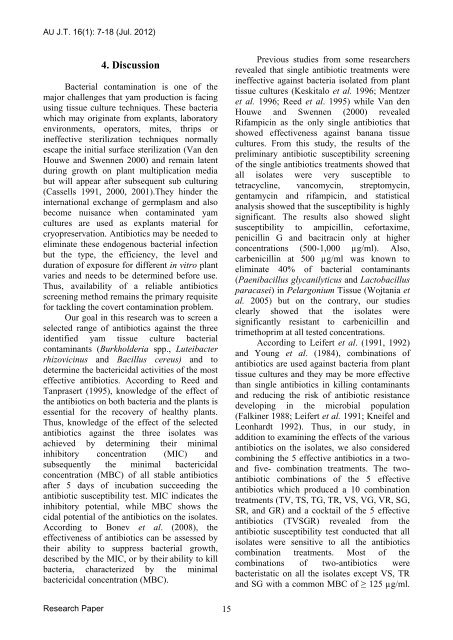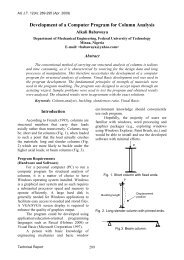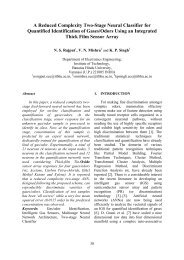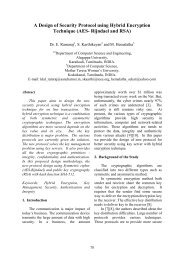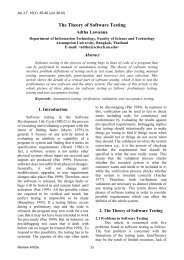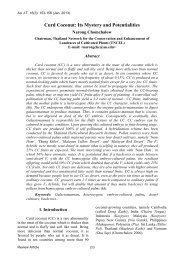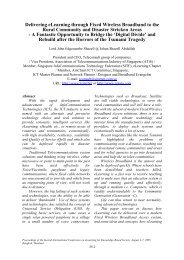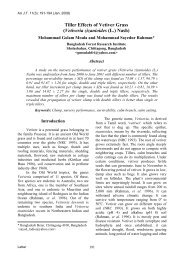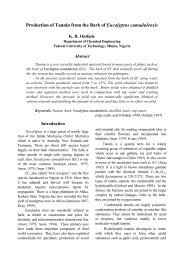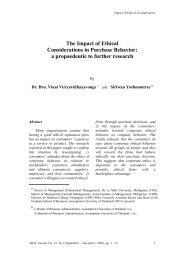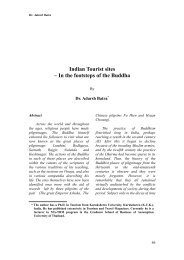Screening Antibiotics for the Elimination of Bacteria ... - AU Journal
Screening Antibiotics for the Elimination of Bacteria ... - AU Journal
Screening Antibiotics for the Elimination of Bacteria ... - AU Journal
You also want an ePaper? Increase the reach of your titles
YUMPU automatically turns print PDFs into web optimized ePapers that Google loves.
<strong>AU</strong> J.T. 16(1): 7-18 (Jul. 2012)<br />
4. Discussion<br />
<strong>Bacteria</strong>l contamination is one <strong>of</strong> <strong>the</strong><br />
major challenges that yam production is facing<br />
using tissue culture techniques. These bacteria<br />
which may originate from explants, laboratory<br />
environments, operators, mites, thrips or<br />
ineffective sterilization techniques normally<br />
escape <strong>the</strong> initial surface sterilization (Van den<br />
Houwe and Swennen 2000) and remain latent<br />
during growth on plant multiplication media<br />
but will appear after subsequent sub culturing<br />
(Cassells 1991, 2000, 2001).They hinder <strong>the</strong><br />
international exchange <strong>of</strong> germplasm and also<br />
become nuisance when contaminated yam<br />
cultures are used as explants material <strong>for</strong><br />
cryopreservation. <strong>Antibiotics</strong> may be needed to<br />
eliminate <strong>the</strong>se endogenous bacterial infection<br />
but <strong>the</strong> type, <strong>the</strong> efficiency, <strong>the</strong> level and<br />
duration <strong>of</strong> exposure <strong>for</strong> different in vitro plant<br />
varies and needs to be determined be<strong>for</strong>e use.<br />
Thus, availability <strong>of</strong> a reliable antibiotics<br />
screening method remains <strong>the</strong> primary requisite<br />
<strong>for</strong> tackling <strong>the</strong> covert contamination problem.<br />
Our goal in this research was to screen a<br />
selected range <strong>of</strong> antibiotics against <strong>the</strong> three<br />
identified yam tissue culture bacterial<br />
contaminants (Burkholderia spp., Luteibacter<br />
rhizovicinus and Bacillus cereus) and to<br />
determine <strong>the</strong> bactericidal activities <strong>of</strong> <strong>the</strong> most<br />
effective antibiotics. According to Reed and<br />
Tanprasert (1995), knowledge <strong>of</strong> <strong>the</strong> effect <strong>of</strong><br />
<strong>the</strong> antibiotics on both bacteria and <strong>the</strong> plants is<br />
essential <strong>for</strong> <strong>the</strong> recovery <strong>of</strong> healthy plants.<br />
Thus, knowledge <strong>of</strong> <strong>the</strong> effect <strong>of</strong> <strong>the</strong> selected<br />
antibiotics against <strong>the</strong> three isolates was<br />
achieved by determining <strong>the</strong>ir minimal<br />
inhibitory concentration (MIC) and<br />
subsequently <strong>the</strong> minimal bactericidal<br />
concentration (MBC) <strong>of</strong> all stable antibiotics<br />
after 5 days <strong>of</strong> incubation succeeding <strong>the</strong><br />
antibiotic susceptibility test. MIC indicates <strong>the</strong><br />
inhibitory potential, while MBC shows <strong>the</strong><br />
cidal potential <strong>of</strong> <strong>the</strong> antibiotics on <strong>the</strong> isolates.<br />
According to Bonev et al. (2008), <strong>the</strong><br />
effectiveness <strong>of</strong> antibiotics can be assessed by<br />
<strong>the</strong>ir ability to suppress bacterial growth,<br />
described by <strong>the</strong> MIC, or by <strong>the</strong>ir ability to kill<br />
bacteria, characterized by <strong>the</strong> minimal<br />
bactericidal concentration (MBC).<br />
Previous studies from some researchers<br />
revealed that single antibiotic treatments were<br />
ineffective against bacteria isolated from plant<br />
tissue cultures (Keskitalo et al. 1996; Mentzer<br />
et al. 1996; Reed et al. 1995) while Van den<br />
Houwe and Swennen (2000) revealed<br />
Rifampicin as <strong>the</strong> only single antibiotics that<br />
showed effectiveness against banana tissue<br />
cultures. From this study, <strong>the</strong> results <strong>of</strong> <strong>the</strong><br />
preliminary antibiotic susceptibility screening<br />
<strong>of</strong> <strong>the</strong> single antibiotics treatments showed that<br />
all isolates were very susceptible to<br />
tetracycline, vancomycin, streptomycin,<br />
gentamycin and rifampicin, and statistical<br />
analysis showed that <strong>the</strong> susceptibility is highly<br />
significant. The results also showed slight<br />
susceptibility to ampicillin, ce<strong>for</strong>taxime,<br />
penicillin G and bacitracin only at higher<br />
concentrations (500-1,000 µg/ml). Also,<br />
carbenicillin at 500 µg/ml was known to<br />
eliminate 40% <strong>of</strong> bacterial contaminants<br />
(Paenibacillus glycanilyticus and Lactobacillus<br />
paracasei) in Pelargonium Tissue (Wojtania et<br />
al. 2005) but on <strong>the</strong> contrary, our studies<br />
clearly showed that <strong>the</strong> isolates were<br />
significantly resistant to carbenicillin and<br />
trimethoprim at all tested concentrations.<br />
According to Leifert et al. (1991, 1992)<br />
and Young et al. (1984), combinations <strong>of</strong><br />
antibiotics are used against bacteria from plant<br />
tissue cultures and <strong>the</strong>y may be more effective<br />
than single antibiotics in killing contaminants<br />
and reducing <strong>the</strong> risk <strong>of</strong> antibiotic resistance<br />
developing in <strong>the</strong> microbial population<br />
(Falkiner 1988; Leifert et al. 1991; Kneifel and<br />
Leonhardt 1992). Thus, in our study, in<br />
addition to examining <strong>the</strong> effects <strong>of</strong> <strong>the</strong> various<br />
antibiotics on <strong>the</strong> isolates, we also considered<br />
combining <strong>the</strong> 5 effective antibiotics in a twoand<br />
five- combination treatments. The twoantibiotic<br />
combinations <strong>of</strong> <strong>the</strong> 5 effective<br />
antibiotics which produced a 10 combination<br />
treatments (TV, TS, TG, TR, VS, VG, VR, SG,<br />
SR, and GR) and a cocktail <strong>of</strong> <strong>the</strong> 5 effective<br />
antibiotics (TVSGR) revealed from <strong>the</strong><br />
antibiotic susceptibility test conducted that all<br />
isolates were sensitive to all <strong>the</strong> antibiotics<br />
combination treatments. Most <strong>of</strong> <strong>the</strong><br />
combinations <strong>of</strong> two-antibiotics were<br />
bacteristatic on all <strong>the</strong> isolates except VS, TR<br />
and SG with a common MBC <strong>of</strong> ≥ 125 µg/ml.<br />
Research Paper 15


